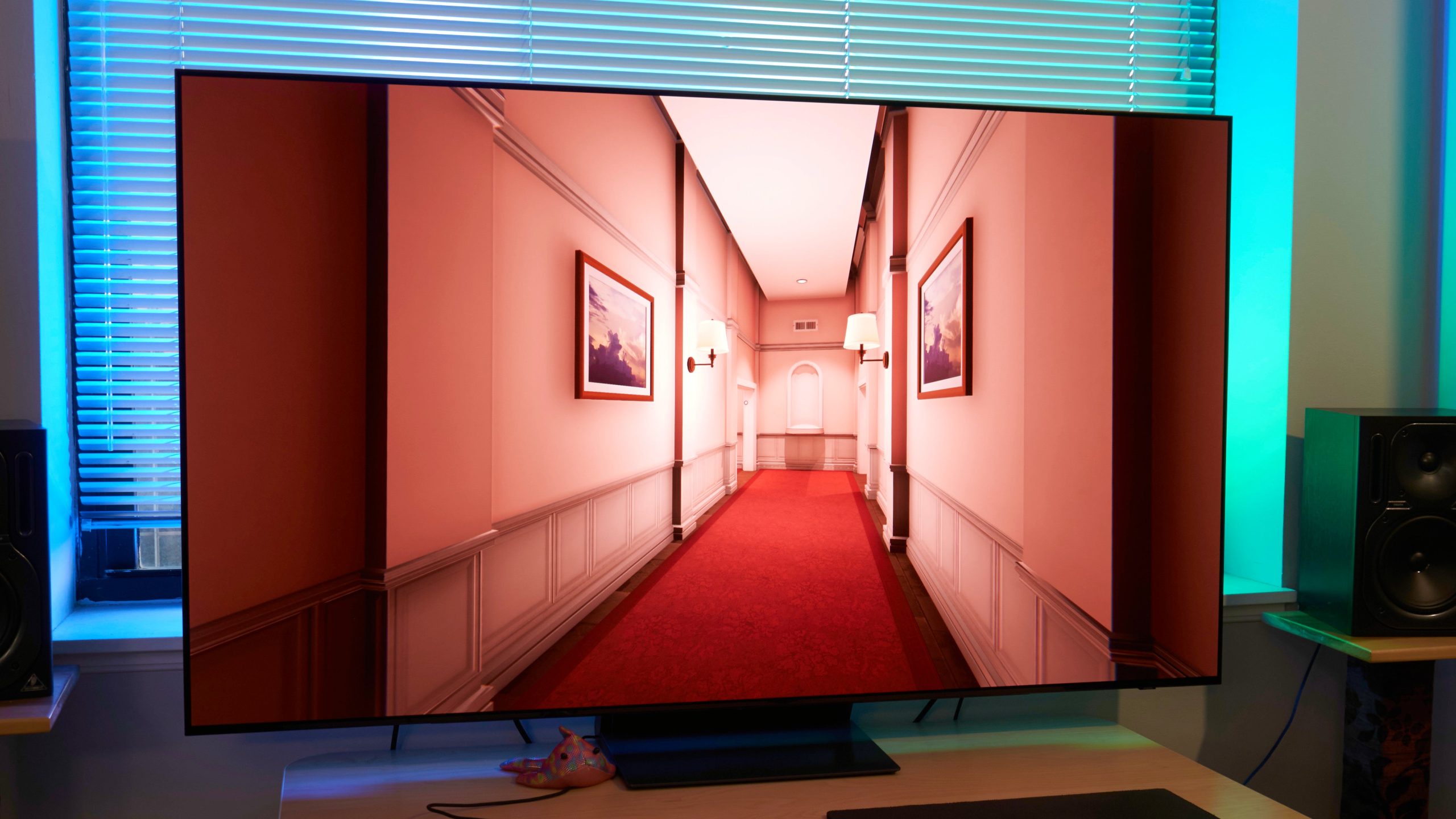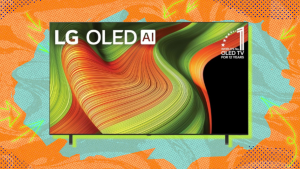
Samsung S90F Review
If you squint, or really just slightly furrow your brow, you’d be hard-pressed to tell the difference between Samsung’s 2025 S90F and the prior year’s S90D. On the exterior, not much has changed. On the interior, also, not much has changed. The 65″ version, which we have in for review, uses the same quantum dot enhanced OLED technology (QD-OLED), same HDR format support (still no Dolby Vision), and has the same maximum refresh rate of 144 Hz with VRR.
None of this is a bad thing, though. The S90F’s picture, like the S90D, is a brilliant thing to take in: 8.3 million individually controlled pixels, better than P3 color gamut, an optical-glass-worthy AR coating, and the smooth, clear gaming performance that comes from instantaneous pixel response. Importantly, though, Samsung has been continually improving the one major weakness of OLED displays: brightness. The S90F pushes highlights beyond 1400 nits and even manages to eke out a decent improvement to fullscreen white.
The $2500 launch price meant that jumping into OLED territory was a significant (and expensive) step beyond FALD LCD competitors like the Hisense U8QG or the TCL QM8K, but in the TV market, it pays to wait. At the time of publishing (October 2025), the 65″ version of the S90F has dropped down to $1,699, and at this price, the Samsung S90F becomes an excellent mid-range TV for movies and gaming.
Samsung S90F – PhotosSetup, First Impressions, and Tizen:Getting the S90F on its stand was a relatively easy affair. The stand snaps together (no screws) and slots into the chunkier housing at the lower back of the display. Most of the screen, though, is unnervingly thin, and looking straight down the top edge of the panel confirms that there’s only a slight bend to the display, nothing major. I don’t love the thinness; the TV’s electronics and IO push the real thickness of the display out to around 1.6 inches, and the rest of the screen, at a scant 4 mm thick, seems unnecessarily delicate and makes handling and moving the display more precarious than it needs to be.
There are three USB ports (with keyboard and mouse support), optical audio, an ethernet jack, RF in, and four HDMI inputs that each support 144 Hz at 4K, which is great to see. Power and IO are strangely on opposite sides of the display, and the included power cable is just short enough to make cable management and external device placement a little tricky.
In my previous review of the Hisense U8QG, I was effusive in praise about the ease of use and setup for its Google TV implementation and I’m still, now especially, impressed with how quickly and easily I could navigate and adjust settings. I have fewer nice things to say about the Samsung S90F and Tizen. In fact, I’m aggravated constantly by the TV.
For me, a TV’s primary user interface should always be immediate, performant, and pared back to only essential functionality, but Tizen feels like a bloated, low-end mobile phone masquerading as a TV menu. When you want to change picture settings (which is something I do quite a lot when reviewing a television), the menu is so slow to load that Samsung had to include a throbber, just so you know the TV hasn’t seized up.
Switching inputs is also slow and cumbersome, first requiring you to drop back to Samsung’s Home/Start screen, move left, then down to “Connected Devices,” whereupon the TV will switch (after a small delay) to whatever the last device was. This home screen was also a major bother to me every time I turned the TV on, where the TV would automatically start playing Nickelodeon on Pluto TV. After some digging into “Advanced Features,” I finally and happily realized I could turn this particular “feature” off. I was about to go ballistic if I had to see another 480p episode of SpongeBob SquarePants when I turned the S90F on.
Samsung’s Tizen OS is trying to do too much. Looking through the marketing material for the TV, surprisingly little of it is actually promoting the TV/display part of the screen. Most of it is Samsung’s attempt to sell the TV as the smart-home HUB device. Do you want to turn on your smart light bulbs with your TV? Or maybe gesticulate with your Galaxy watch instead of using the remote control? Tizen’s got you covered. Samsung is even touting an AI-enabled dog bark detection feature that will alert you when your dog is stressed, and it’ll play custom content to soothe and comfort the dog while you’re away. Will someone find this useful? Perhaps. But if the dog barking AI feature is the reason I have to wait on a loading screen every time I want to change the picture mode, I just don’t need it.
By trying to do too much, Samsung is hurting the usability of the S90F as a TV. In contrast, the Google TV implementation in Hisense’s U8QG may seem a bit more bare-bones, but navigating the menu is refreshingly simple compared to the Samsung.
Reflection HandlingThe anti-reflective coating on the Samsung S90F is incredible. It actually reminds me of the vacuum deposited AR coated glass on my Trinitron CRT. Even though the screen has a mirror-like gloss, reflected light is deeply attenuated, taking on a purple hue. The image above, taken at the same exposure, compares Hisense’s very good AR coating on the U8QG with the S90F, which performs even better. Reflections are darker and there’s no rainbow-like diffraction effect.
Your room or ceiling lights, windows, etc., will be visible as reflections, but I never found them distracting, even in my less-than-ideal, very bright living room setup. OLEDs can’t maintain the same full-scene brightness that FALD-driven VA televisions can muster, so for daytime viewing, it’s important that manufacturers get the screen coating right, and Samsung has done a great job here.
SoundThe built-in speakers on the S90F are… fine. I’ll continue to recommend that home theater enthusiasts (and you likely fall into that camp if you’re considering an OLED) opt for a discrete sound solution, but the stereo speakers on the Samsung will work in a pinch.
Most of the OLED screen itself is far too thin to house the speakers, so Samsung placed the drivers at the bottom of the screen, facing down and firing into the stand. If you’re using the included stand and not wall-mounting, this configuration works better than rear-facing speakers since it tends to give a more direct and precise stereo image. As a result, center-channel dialogue is clear and intelligible, and music is decent enough at low-ish volumes.
The OLED DifferenceWhen people talk about OLED displays, the two main talking points typically are near-perfect response times and their ability to produce actually perfect blacks. After spending some time with Samsung’s S90F, however, two aspects of OLED really stand out to me as the major differentiators that separate the LCD experience from the OLED one:
Near-perfect viewing anglesExtreme, local contrastAt the S90F’s max refresh rate of 144 Hz (a 6.94 ms frame time), the dominant form of motion blur is sample and hold, so a 0.2 millisecond response time, while nice, isn’t 10x better than a 2 millisecond response time. It also turns out that very little actual movie or game content is pure black. Yes, the title screen or developer logos or end credits might be placed against a black background (and a FALD backlight on a VA panel handles those situations well enough), but most content that we typically consider dark or contrasty – “ideal for OLED” – is in the 0.1 to 1 nit range, never fully black. This means that OLED’s ability to turn off pixels is less important than you might think.
What makes the difference, though, is how the various panels display this very dark content. For my previous review of Hisense’s U8QG, an excellent full array backlit VA television, I spent a lot of time watching the HDR version of Until Dawn on Netflix. This week, for the Samsung, it’s been The Wild Robot. Both movies are replete with richly detailed, very dark scenes.
The problem for Hisense is that VA panels inherently suffer from a viewing angle dependent gamma shift for dark shades, which causes the luminance (or brightness) or the scene to shift depending on the angle and position of your head. When watching these two movies on the U8QG, I found myself subconsciously moving around, angling myself to get this best picture, scooching back a few feet to reduce my viewing angle to the screen’s periphery.
In comparison, on the S90F OLED, the picture is perfectly stable no matter where you are or how close you get to the screen. This is such a refreshing change from PC monitor IPS glow and VA gamma shift, and it’s why I think OLED viewing angle superiority is the most important aspect that should guide your buying decisions on OLED vs VA.
If you’re a snob for image quality and intending to watch a lot of dark, moody content, and/or you’d like your equally snobby friend sitting next to you to get the same experience, OLED is simply a better choice than LCD.
In my testing of the Hisense U8QG, I found that, under specific conditions, the FALD backlight was basically a 4000 nit light cannon, and any time an approximately 10% white logo would appear on a black background, I’d be experiencing the video version of the classic Maxell guy-in-chair ad. But this capability was substantially diminished in normal content, peaking at 1300 nits, at best.
But here’s the difference I saw with the S90F: the Samsung can match or exceed those real-content nit values, which we’ll get into soon, but instead of an eight to ten zone-sized blob of luminance, the OLED can get highly specifically bright at just the areas it needs to be. Roz from The Wild Robot is greebled with thin RGB lighting strips, and the S90F’s picture really impressed me with how crisply bright these highlights were. This extreme local contrast is missing from normal FALD backlit televisions, and it gives the image a depth and realism that those VA models lack. RGB light strips, laser beams, the lamp in a distant street light, specular highlights… they’re all dazzling at 1400 nits.
The clear superiority of OLED for local contrast and viewing angles may make it seem like VA is a non-starter for the home theater enthusiast, but OLED is still weak in two important areas: full screen brightness and cost. We’ll cover brightness soon, but I want to start with pricing. At the release price of $2499 for the 65” version, the S90F would be double the cost of the Hisense U8QG. Is it twice as good? Probably not, but you can usually find the Samsung on sale below $1700. At that price, the decision gets much harder.
Color, Calibration, and SDRI like to begin the calibration process by capturing the “backlight” spectrum of the display. The 65″ variant of the S90F I have in for review uses a QD-OLED panel, with a triangular RGB subpixel structure, but this isn’t true for the other sizes, so be cautious if you’re making a purchase. Samsung made the curious decision to use WOLED panels in the S90F’s other size variants, which is confusing and borderline deceptive.
In the case of the 65”, a blue emitting layer energizes the quantum dots for the red and green subpixels. The resulting spectrum shows broad, distinct RGB peaks, very similar to the Hisense U8QG, which also uses quantum dots.
All the primaries extend beyond the DCI-P3 color space. Samsung does have gamut clamps (“Normal” for DCI-P3 or “Auto” for sRGB in PC mode) if you’re a stickler for calibration, but I generally tend to prefer leaving the panel in its native mode, which gives the most vivid color presentation.
Other than my quibbles with Tizen’s slow loading menus, Samsung does give a good variety of options for calibration, and I spent quite a lot of time here. The menu can be scaled down, which is great for getting it out of the way so you can see your adjustments in real-time.
The TV defaults to the Warm1 picture mode, which is a bit too cool, so I’d recommend swapping to Warm2, which gets the starting point closer to 6500K. 20-point white balance correction isn’t available in Game mode, but a small adjustment to 2-point WB pinches the 35 and 70 percent white color balance points very close to a perfect 6500K with low Delta E’s across the board.
Samsung S90F – Performance ChartsIn SDR, the S90F has two gamma options: 2.2 and BT1886. Both measure almost identically, with averages of 2.17 and 2.25 respectively, and very little visual difference between them. My SDR measurements were taken using BT1886.
The Samsung S90F seems to have a hard limit of 250 nits fullscreen, whether in SDR or HDR, but the behavior of smaller window sizes, or highlights, varies quite a bit depending on the exact size of the test patch. Interestingly, with a black background, the S90F can maintain around 660 nits all the way to up to a 25% window, which is impressive. I only wish that Samsung would allow SDR highlights to hit the peak numbers (~1400) that it can do in HDR. 660 nits is bright, but it doesn’t really allow SDR content – the vast majority of games and movies – to have the luminance pop and dazzle that the FALD backlit Hisense U8QG can achieve.
Patch measurements taken with a 5% gray background (RGB 13) – much more representative of real content than with a pure black background – are slightly depressed, down to around 630 nits, but the S90F has a peculiar behavior in this situation: the 5% background basically disappears when the test patch is illuminated. It seems the S90F can’t maintain an even gray background when the patch is shown, perhaps an issue with Samsung’s ABL algorithm. In any case, it makes comparisons with other displays that can maintain a consistent 5% background a little difficult.
Even with these limitations, SDR content still looks amazing on the S90F. And if you allow the slight inaccuracy from running the unclamped, native gamut, even a bog-standard-definition signal from a game like Superliminal will impress.
HDROn properly mastered content, HDR looks stunning on the S90F. As I mentioned previously, OLED’s stark local contrast combined with really good HDR brightness makes for a better HDR experience than you get on a locally dimmed VA panel, and that was absolutely borne out as I watched scenes from The Wild Robot and The Umbrella Academy. Outside of Game mode, Samsung does allow the S90F to get a little brighter, and watching light pouring in from Hotel Obsidian’s windows at 1400 nits is wonderful.
EOTF tracking in HDR is near perfect; only the darkest parts of the image, below about 1 nit, are a little brighter than expected. All my primary testing was done in Game Mode, and here Samsung is a little more conservative with peak brightness, limiting the S90F to around 1300 nits at both the 2% and 10% window sizes with a black background. With a more realistic 10 nit background, both window sizes top out at 1200 and 1140 nits respectively. For larger window sizes, the HDR and SDR brightness measurements converge, and both peak at 250 nits fullscreen, which is a bit disappointing.
I test down to 0.05 nits, which may seem extremely dark, but there is a lot of important content below 1 nit, and presenting it accurately is important. Still using the Warm2 color temperature setting and a few small tweaks to gain and offset, the S90F does a remarkable job of keeping a consistent 6500K color balance deep into near black, with only a small blue push, nearly imperceptible, evidenced by the extremely low Delta E values.
The S90F offers an HDR experience where small highlights and details are dazzlingly bright, colors are deep, rich, and accurate, but it’s unfortunately limited by poor fullscreen brightness that makes bright room viewing dimmer and less impactful than its LCD competition.
Response Times, Gaming, and the S90F as a PC MonitorWhether you’re interested in a very large PC gaming monitor (like I am) or a high-refresh rate living room console-gaming display, the S90F is a fantastic choice for gamers. With (mostly) sub-millisecond response times, input lag that competes with some of the best gaming monitors, and a max refresh rate of 144 Hz with VRR, the S90F is head and shoulders above its VA-LCD equipped competitors like the Hisense U8QG or TCL QM8K, whose response times simply can’t keep up. My only real gripes are that Samsung didn’t give us an even higher refresh rate mode (where’s the integer-scaled 1080p mode at 288 Hz?) and the ever-present potential for VRR flicker, inherent to OLED displays.
My gamma-corrected response time charts for the S90F may seem a little strange at first. Most responses are near-instant: 150 microseconds – exactly as we’d expect for an OLED. But a smattering of slow-ish transitions, usually around the frame-time length of the refresh rate, brings the average to around 1 millisecond for the 60 Hz, 120 Hz, and 144 Hz modes.
A great example of one of these long response times is the transition from black to RGB 223 at 60 Hz, which takes a glacial 17.2 ms. The transition quickly jumps to around RGB 210 and then has a long, gradual rise to 223 over the next 16.6 milliseconds. The graph shows a comparison with the transition from RGB 31 to 223, which only takes 0.18 ms. Is this difference visible? Surprisingly, yes! In moving test patches, the asymmetry between the slow rise time and the instant falling time can be seen as a shade difference between the leading and trailing edges of moving objects, but you’d have to be very perceptive (and very picky) to spot this while playing games. Don’t let some of my slower measurements for the S90F scare you away; Samsung’s OLED panel is basically as good as it gets for response times.
The experience in a game like Superliminal is extraordinary. The game goes from bright, colorful rooms to sparsely and dimly lit corridors. Unlike VA panels that tend to smear dark scenes, the S90F’s motion performance is extremely fast and consistent, limited only by the sample-and-hold blur at 144 FPS. In fact, the game is so smooth at 144 Hz, it makes me wish that Samsung pushed the refresh rate even higher. The S95F, for a lot more money, offers a marginally higher 165 Hz max refresh rate, but that isn’t enough to really move the needle; a 240 or 288 Hz mode would be a very welcome addition.
Pursuit photos of the TestUFO alien reinforce the notion that the S90F is a basically a pure sample-and-hold limited display. At 1920 pixels per second panning speed, which is fast, all the UFO blur is a result of image persistence rather than response times; there’s no unusual smearing, ghosting, or overdrive artifacts.
In Game Mode, input lag on the S90F is low at all refresh rates, coming in around 1 millisecond at 144 Hz, 1.2 ms at 120 Hz, and 6 ms at 60 Hz. Latency under 10 ms is all but imperceptible except to try-hardest of try-hards (my tested limit is around 6 ms), so even PC gamers used to the immediacy of mouse movement on a gaming monitor won’t be disappointed with this television.
For the 65” variant (QD-OLED only), the S90F uses a triangular G/RB subpixel layout, with the green subpixel on its own row. This unusual layout hurts fine text clarity and can cause green and purple fringing on the top and bottom of high contrast elements like text and desktop windows. The super-macro above shows the S90F’s rendering of “Aug” in a tiny 9-pt font. While better than the U8QG’s rendering, Samsung’s OLED structure has more trouble making small fonts legible than a traditional RGB stripe.
Not everyone, of course, intends to use a 65” TV on their desk, and this problem mostly disappears at reasonable viewing distances.
VRR FlickerVRR flicker is a problem for all OLEDs, and the S90F is no exception. While gaming, large frame time swings, whether caused by a shader compilation hitch, unoptimized code, or even background tasks, can cause rapid changes in dark-level luminance – essentially a gamma change – which takes on the appearance of a flicker or flash.
For the S90F, this typically happens when the display crosses the LFC threshold, and the panel’s physical refresh rate either immediately doubles or halves, e.g. a 56 FPS game scene causes the display to oscillate between 56 Hz and 112 Hz, and because the dark-level gamma changes with refresh rate, we get the VRR flicker effect.
This is a bit difficult to measure because the onset of LFC changes depending on a myriad of factors: the display, the GPU, GPU drivers, the direction of the framerate change (rising or falling), LFC framerate hysteresis, etc. But I did manage to take a series of dark-level test patch measurements for 60 FPS versus 144 FPS, and the change in luminance is pretty easy to spot. At around RGB 21, the luminance responses start to diverge, and by RGB 60, there’s an easily noticeable difference between the different frame rates.
All that said, I didn’t experience much VRR flicker in my gaming tests with the S90F (Superliminal, Doom: The Dark Ages, Quake Champions), but this is highly game specific, as World of Warcraft or Alan Wake 2 players can attest: it’s not a problem until it is. Maintaining a consistent framerate is key, but that’s not something you ever have full control over. If you’re buying an OLED, just be aware that VRR flicker is a very real possibility.











